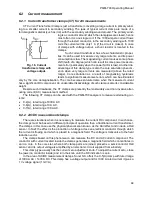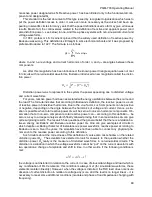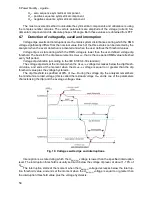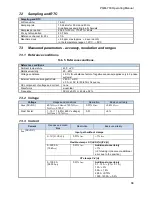
6 Power Quality - a guide
51
allowed only after a clear reservation that the indicated value is not a result of actual measurement,
but only an approximated value.
6.4.4 Reactive power and reactive energy meters
Reactive energy meters are devices unknown to the household users who for settlements with
energy suppliers use the meters of active energy expressed in Wh or kWh. Household users are in
a comfortable situation
– they pay only for usable energy and do not have to think what the power
factor is in their installations.
In contrast to the first group, the industrial consumers are obliged in their contracts and some-
times under pain of financial penalties to keep the power factor at an appropriate level.
The EN 50160 standard gives some guidelines for the power quality requirements, and defines
the quality parameters which should be met by energy supplier. Among these parameters are,
among others, mains frequency, RMS voltage, total harmonic distortion (THD) and allowed levels
of individual voltage harmonics. Besides EN 50160 requirements there is often an additional condi-
tion: the supplier does not need to comply with those requirements if an energy consumer does not
ensure the
tan
factor below some threshold (agreed value which can be changed in the contract
between the energy supplier and consumer, i.e. 0.4) and/or exceeds the agreed level of consumed
active energy.
The
tan
is defined as a ratio of measured reactive energy to the active energy in a settlement
period. Going back for a while to the power triangle in sinusoidal systems, we can see that the
tangent of the phase shift angle between the voltage and the current is equal to the ratio of reactive
power Q to active power P. Consequently, the requirement to maintain the
tan
below 0.4 means
nothing else but only that maximum level of measured reactive energy may not exceed 0.4 of the
measured active energy. Each consumption of reactive energy above this level is subject to addi-
tional fees.
Does the knowledge of
tan
calculated in this manner give both interested parties an actual
view of energy transmission effectiveness? Have we not mentioned before that the reactive power
is only one of the nonactive power components which influence the power factor reduction?
Indeed, it seems that instead of
tan
we should use the power factor PF which takes into account
also other issues.
Unfortunately, if the present regulations leave no choice, than the correct reactive power meas-
urement seems a key matter. Now, a question should be asked whether the reactive energy meters
ensure correct readings in the light of the controversies described above. And what do such widely
used meters really measure?
One can attempt to look for answers to these questions is the standard on such meters - IEC
62053-23. Unfortunately, to our disappointment, we will not find there any reference to measure-
ments in non-sinusoidal conditions
– the calculation formulas relate to sinusoidal conditions (we can
read in the standard that due to “practical” reasons, non-sinusoidal waveforms have been ex-
cluded). The standard does not give any measurement criteria which would allow checking the me-
ter properties at distorted voltage and current waveforms. As a surprise comes also the fact that the
older standard IEC 61268 (already withdrawn) defined the test which involved checking the meas-
urement accuracy at 10% of the third current harmonic.
The present situation leaves the choice of measuring method to the meters designers, which
unfortunately leads to significant differences in reactive energy indications in the presence of high
harmonic distortion level.
Older, electromechanical meters have characteristics similar to that of a low-pass filter
– higher
harmonics are attenuated in such meters and the reactive power measurement in the presence of
harmonics is very close to the value of reactive power of the fundamental component.
Electronic meters which are more and more popular can perform the measurement with various
methods. For example, they can measure active and apparent power, and then calculate the reac-
tive power from the power triangle (square root from the sum of both such powers squared). In
reality, in the view of the IEEE 1459-2000 standard, they measure the nonactive power, not the
reactive power. Another manufacturer may use the method with voltage waveform shift by 90
,
which gives a result close to the reactive power of the fundamental component.
Summary of Contents for PQM-700
Page 85: ...85 Notes...
















































